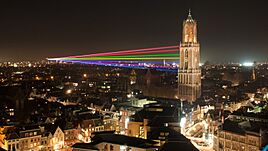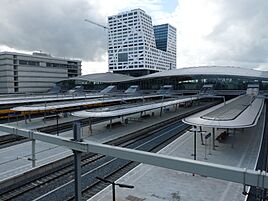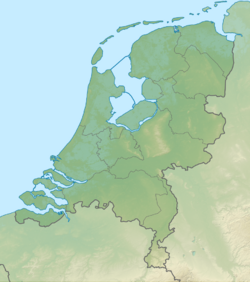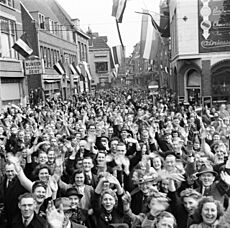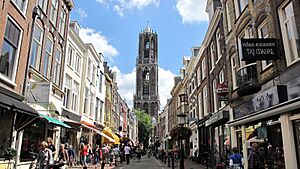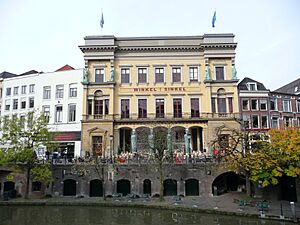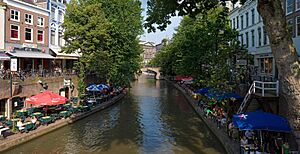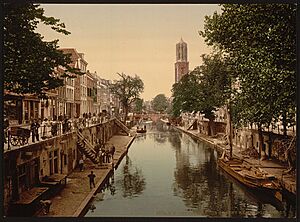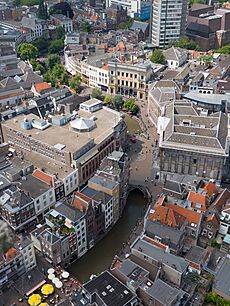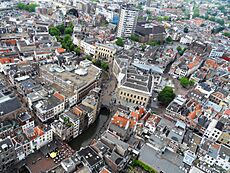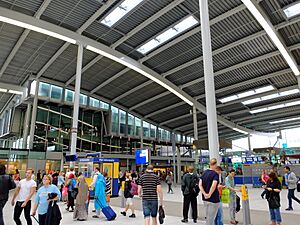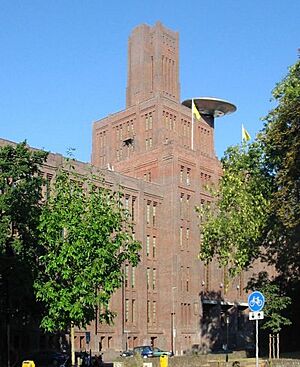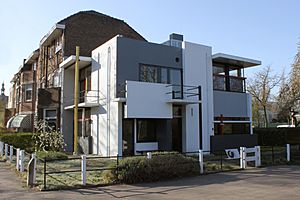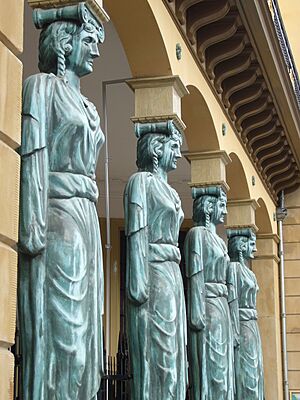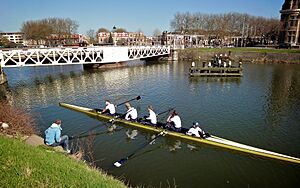Utrecht facts for kids
Quick facts for kids
Utrecht
Ut(e)reg (Utrechts)
|
|||||
|---|---|---|---|---|---|
|
City and municipality
|
|||||
|
Dom Tower of the St. Martin's Cathedral
Jaarbeursplein
Uithof centre in Utrecht Science Park
Spoorwegmuseum
Neude
Utrecht Centraal railway station
|
|||||
|
|||||
| Nickname(s):
Domstad (Cathedral City)
|
|||||
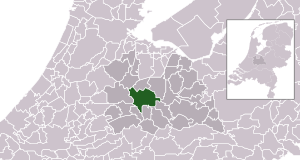
Location of Utrecht municipality
|
|||||
| Country | Netherlands | ||||
| Province | Utrecht | ||||
| Government | |||||
| • Body | Municipal council | ||||
| Area | |||||
| • Municipality | 99.21 km2 (38.31 sq mi) | ||||
| • Land | 94.33 km2 (36.42 sq mi) | ||||
| • Water | 4.88 km2 (1.88 sq mi) | ||||
| • Randstad | 3,043 km2 (1,175 sq mi) | ||||
| Elevation | 5 m (16 ft) | ||||
| Population
(1 January 2025)
|
|||||
| • Municipality | 376,435 | ||||
| • Density | 3,646/km2 (9,440/sq mi) | ||||
| • Urban | 489,734 | ||||
| • Metro | 656,342 | ||||
| • Randstad | 6,979,500 | ||||
| Demonym(s) | Utrechter(s) | ||||
| Time zone | UTC+1 (CET) | ||||
| • Summer (DST) | UTC+2 (CEST) | ||||
| Postcode |
3450–3455, 3500–3585
|
||||
| Area code | 030 | ||||
Utrecht is the fourth-largest city in the Netherlands. It is also the capital and biggest city of the Utrecht province. The city is located in the middle of the Netherlands. It is part of a large urban area called the Randstad. Utrecht includes smaller towns like Haarzuilens, Vleuten, and De Meern. As of January 2025, about 376,435 people live here.
Utrecht's old city center has many historic buildings. Some of these buildings are from the High Middle Ages. The city has been a major religious center in the Netherlands since the 700s. In 1579, an important agreement called the Union of Utrecht was signed here. This agreement helped create the Dutch Republic. Utrecht was the most important city in the Netherlands for a long time. Later, during the Dutch Golden Age, Amsterdam became more important.
Today, Utrecht is home to Utrecht University, which is the largest university in the Netherlands. It also has other colleges. Because it is in the center of the country, Utrecht is a key place for both trains and roads. Its main train station, Utrecht Centraal, is the busiest in the Netherlands. Utrecht also has many cultural events, second only to Amsterdam. In 2012, Lonely Planet listed Utrecht as one of the world's top "unsung places."
Contents
History of Utrecht
Early Beginnings (Before 650 CE)

People lived in the Utrecht area as far back as the Stone Age (around 2200 BCE). But the city really began around 50 CE. This is when the Romans built a fort called a castellum. The Romans built these forts along the Rhine river to protect their border. The Rhine used to flow differently back then. Each fort held about 500 Roman soldiers. Small towns grew around these forts, where artisans, traders, and soldiers' families lived.
The Roman fort in Utrecht was simply called Traiectum. This name meant "crossing place" on the Rhine. Later, "Traiectum" became "Trecht" in Dutch. The "U" was added to make it "U-trecht" and tell it apart from Maas-tricht. Around 200 CE, the wooden walls of the fort were replaced with strong stone walls. You can still find parts of these walls under buildings near Dom Square today.
Around 275 CE, Germanic tribes started attacking Roman lands. The Romans could no longer hold their northern border, and Utrecht was left empty. Not much is known about Utrecht from 270 to 650 CE. The city is mentioned again when the Franks grew powerful. In the 600s, a church was built inside the old Roman fort. But this first church was destroyed during fights with the Frisians.
A Christian Center (650–1579)
In the mid-600s, missionaries from Britain and Ireland came to convert the Frisians. Pope Sergius I made Saint Willibrordus the bishop of the Frisians. This is seen as the start of the Bishopric of Utrecht. In 723, the Frankish leader Charles Martel gave the Utrecht fort and nearby lands to the bishops. From then on, Utrecht became a very important center for the Catholic Church in the Netherlands.
Utrecht was also important for trade. After the nearby trading town of Dorestad fell around 850, Utrecht became one of the most important cities in the Netherlands. Its importance as a Christian center is shown by the election of Adriaan Florenszoon Boeyens from Utrecht as pope in 1522. He was the last non-Italian pope before John Paul II.
Prince-Bishops and Their Power
When the Frankish rulers created the feudalism system, the Bishops of Utrecht also gained worldly power. They became prince-bishops. Their territory included not only the modern province of Utrecht but also lands to the northeast. The Middle Ages were full of conflicts, and Utrecht was often involved in wars with other powerful rulers.
Important Religious Buildings
Many churches and monasteries were built in and around Utrecht. The most famous is the Cathedral of Saint Martin. It was built inside the old Roman fort. Construction of the current Gothic church began in 1254. This was after an older church was damaged by fire. The Dom tower was a very ambitious project. However, the central part of the church was never fully finished.
Besides the cathedral, Utrecht had four other important churches. These included St. Salvator's Church (from the early 700s), Saint John (from 1040), Saint Peter (from 1039), and Saint Mary's church (from around 1090). The city also had other religious buildings like St. Paul's Abbey.
Utrecht as a City
Utrecht's location on the Rhine river helped it become a major trade center. The town was given city rights by Henry V on June 2, 1122. As the main flow of the Rhine changed, the old riverbed through the city became a canal. A unique system of wharfs was built along the canals. These wharfs had storage cellars at water level, with streets and houses built on top. This created a special two-level street system.
The relationship between the bishop and the citizens was not always easy. For example, the bishop once dammed the Kromme Rijn river. This was to protect his lands from flooding. But it made shipping difficult for the city. So, Utrecht built a new canal, the Vaartse Rijn, to keep its trade routes open.
Losing Independence
In 1528, the bishop lost his worldly power over Utrecht to Charles V, Holy Roman Emperor. Charles V brought many regions, including Utrecht, under his rule. This ended Utrecht's time as a prince-bishopric. The city became part of the lordship of Utrecht. Charles V also gained the right to choose new bishops. In 1559, the bishopric of Utrecht was made an archbishopric. This made it the main religious center for the northern parts of the Netherlands.
The people of Utrecht did not easily accept losing their independence. To stop rebellions, Charles V built a strong castle called Vredenburg. It housed many soldiers to control the city. But the castle lasted less than 50 years. It was torn down during an uprising at the start of the Dutch Revolt.
The Dutch Republic (1579–1806)
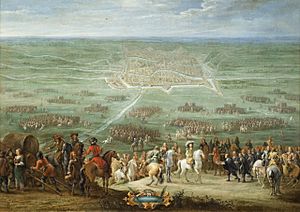
In 1579, seven northern provinces signed the Union of Utrecht treaty. They agreed to fight together against Spanish rule. This union is seen as the beginning of the Dutch Republic. In 1580, the new, mostly Protestant state ended the power of the bishops. This included the archbishopric of Utrecht. The new leaders of the republic did not like Utrecht's independent spirit. They brought the city under tighter control, shifting power to the province of Holland. This led to a long period where trade and growth in Utrecht slowed down.
Utrecht remained different from other cities in the new republic. About 40% of its people were Catholic in the mid-1600s. In 1672, the French army invaded the Netherlands. Utrecht was taken by the French king Louis XIV. The French invasion was stopped just west of Utrecht. In 1674, a tornado hit Utrecht. The unfinished central part of the Dom Church collapsed. This created the Dom Square we see today, separating the tower from the rest of the church. In 1713, Utrecht hosted important peace talks. The Treaty of Utrecht ended the War of the Spanish Succession.
Modern Utrecht (1815–Present)
In the early 1800s, Utrecht's role as a fortified city was no longer needed. The city walls were taken down to allow the city to grow. The old moats remained and became part of a beautiful park called the Zocher plantsoen. The city grew even faster after a railway connecting Utrecht to Amsterdam opened in 1843. Utrecht then became the main hub of the Dutch railway network.
When the Catholic bishopric of Utrecht was brought back in 1853, Utrecht again became a center for Dutch Catholicism. From the 1880s, new neighborhoods were built around the old city. In the 1920s and 1930s, new middle-class areas were built. During this time, famous buildings like the Rietveld Schröder House (1924) and the city theatre (1941) were constructed.
During World War II, German forces occupied Utrecht. British and Canadian troops entered the city on May 7, 1945, after the German surrender. After the war, Utrecht grew a lot. Many new neighborhoods were built. Around 2000, the Leidsche Rijn area was developed as a large new part of the city to the west.
The area around Utrecht Centraal railway station was redeveloped in the 1960s. This included building the Hoog Catharijne shopping mall. Part of the old canal system was even turned into a highway. But people protested against more changes to the city center. In the early 2000s, the area was changed again. The new TivoliVredenburg music center opened in 2014. It brought together different music venues into one building.
Geography and Climate
Utrecht's Weather
Utrecht has a mild oceanic climate. This is similar to the rest of the Netherlands. It means the city has cool winters and mild summers. It gets rain throughout the year.
| Climate data for De Bilt | |||||||||||||
|---|---|---|---|---|---|---|---|---|---|---|---|---|---|
| Month | Jan | Feb | Mar | Apr | May | Jun | Jul | Aug | Sep | Oct | Nov | Dec | Year |
| Record high °C (°F) | 15.1 (59.2) |
18.9 (66.0) |
23.9 (75.0) |
28.9 (84.0) |
33.6 (92.5) |
36.8 (98.2) |
37.5 (99.5) |
35.3 (95.5) |
34.2 (93.6) |
26.7 (80.1) |
18.7 (65.7) |
15.3 (59.5) |
37.5 (99.5) |
| Mean daily maximum °C (°F) | 6.1 (43.0) |
7.0 (44.6) |
10.5 (50.9) |
14.8 (58.6) |
18.3 (64.9) |
20.9 (69.6) |
23.1 (73.6) |
22.9 (73.2) |
19.5 (67.1) |
14.8 (58.6) |
9.9 (49.8) |
6.7 (44.1) |
14.6 (58.3) |
| Daily mean °C (°F) | 3.6 (38.5) |
3.9 (39.0) |
6.5 (43.7) |
9.9 (49.8) |
13.4 (56.1) |
16.1 (61.0) |
18.2 (64.8) |
17.8 (64.0) |
14.7 (58.5) |
10.9 (51.6) |
7.0 (44.6) |
4.2 (39.6) |
10.6 (51.1) |
| Mean daily minimum °C (°F) | 0.9 (33.6) |
0.7 (33.3) |
2.4 (36.3) |
4.5 (40.1) |
8.0 (46.4) |
10.8 (51.4) |
13.0 (55.4) |
12.5 (54.5) |
10.0 (50.0) |
7.1 (44.8) |
3.9 (39.0) |
1.6 (34.9) |
6.3 (43.3) |
| Record low °C (°F) | −24.8 (−12.6) |
−21.6 (−6.9) |
−14.4 (6.1) |
−6.6 (20.1) |
−3.7 (25.3) |
0.2 (32.4) |
3.2 (37.8) |
3.8 (38.8) |
−0.7 (30.7) |
−7.8 (18.0) |
−14.4 (6.1) |
−16.6 (2.1) |
−24.8 (−12.6) |
| Average precipitation mm (inches) | 70.3 (2.77) |
62.7 (2.47) |
57.4 (2.26) |
41.1 (1.62) |
58.9 (2.32) |
70.1 (2.76) |
84.8 (3.34) |
83.1 (3.27) |
77.5 (3.05) |
80.7 (3.18) |
79.7 (3.14) |
83.4 (3.28) |
849.7 (33.45) |
| Average precipitation days (≥ 1 mm) | 12 | 10 | 11 | 9 | 10 | 10 | 10 | 10 | 11 | 12 | 13 | 12 | 131 |
| Average snowy days | 6 | 6 | 4 | 2 | 0 | 0 | 0 | 0 | 0 | 0 | 2 | 5 | 25 |
| Average relative humidity (%) | 87 | 84 | 81 | 75 | 75 | 76 | 77 | 79 | 84 | 86 | 89 | 89 | 82 |
| Mean monthly sunshine hours | 66.6 | 89.6 | 139.4 | 189.2 | 217.5 | 207.1 | 213.9 | 196.3 | 152.8 | 119.3 | 67.4 | 55.5 | 1,714.6 |
| Source 1: Royal Netherlands Meteorological Institute (1991–2020 normals, snowy days normals for 1971–2000) | |||||||||||||
| Source 2: Royal Netherlands Meteorological Institute (1901–present extremes) | |||||||||||||
Population of Utrecht
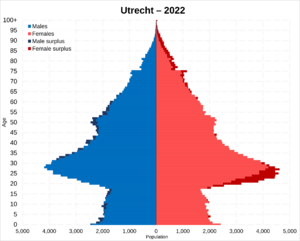
In 2022, Utrecht city had a population of 361,924 people. The city is still growing. It is expected to have over 392,000 people by 2025.
Utrecht has a young population. Many people are between 20 and 30 years old. This is because of the large university in the city. About 52% of the people are female, and 48% are male. Most households (52.5%) in Utrecht are single-person households. About 29% of people are married or in a legal partnership.
People's Backgrounds
About 62.8% of Utrecht's population has both parents born in the Netherlands. Around 12.4% of the people have a recent family background from Western countries. About 24.8% of the population has at least one parent from a 'non-Western' country. This includes 8.8% from Morocco and 4% from Turkey.
Religious Life
Utrecht has been a religious center since the 700s. Today, it is the home of the main Archbishop of Utrecht. This leader is the most senior Dutch Roman Catholic. Utrecht is also the home of the archbishop of the Old Catholic Church. The offices of the Protestant Church in the Netherlands are also located here.
As of 2013, Christianity is the largest religion in Utrecht, with 28% of the population being Christian. Islam is the second largest, with 9.9% in 2016. Hinduism makes up 0.8% of the population.
Religions in Utrecht (2013) None (61.0%) Roman Catholic (13.4%) Protestant Church in the Netherlands (10.2%) Other Christian denominations (4.4%) Islam (9.5%) Hinduism (0.8%) Buddhism (0.6%) Judaism (0.1%)
City Areas
Utrecht is divided into 10 city quarters. Each quarter has its own local council.
- Binnenstad (City Center)
- Oost (East)
- Leidsche Rijn
- West
- Overvecht
- Zuid (South)
- Noordoost (Northeast)
- Zuidwest (Southwest)
- Noordwest (Northwest)
- Vleuten-De Meern
Utrecht is the center of a very populated area. The smaller urban area of Utrecht has about 420,000 people. This includes nearby towns like Nieuwegein and Maarssen. If you include slightly further cities like Woerden and Amersfoort, the total population reaches about 820,000.
City Government
Utrecht is governed by a Municipal Council. The council has members from different political parties. The current mayor is Sharon Dijksma.
Cityscape and Landmarks
The Dom Tower is the most famous landmark in Utrecht. It is the tallest bell tower in the Netherlands, standing 112 meters (367 feet) tall. It was originally part of the Cathedral of Saint Martin. There is a discussion about whether any new building in the city center should be taller than the Dom Tower. However, some new tall buildings have been built. The Rabobank-tower, finished in 2010, is 105 meters (344 feet) tall.
Another important part of Utrecht's look is its old center and canals. The Oudegracht is a curved canal that follows an old branch of the Rhine river. It has unique wharf-basement structures. These create a two-level street along the canals. The inner city still looks much like it did in medieval times. The moat around the old town is mostly still there. In the 1970s, part of the moat was turned into a motorway. But it was changed back into a waterway, with work finished in 2020.
Because Utrecht was a fortified city, building outside the old city walls was limited until the 1800s. Around the medieval center, there is a ring of neighborhoods from the late 1800s and early 1900s. Newer neighborhoods are further out. The eastern part of Utrecht remains quite open. This is because the Dutch Water Line defense system needed clear views, so no permanent buildings were allowed there until the mid-1900s.
Many impressive churches were built in Utrecht because of its religious history. Most famous is the Dom Church. Other notable churches include the Romanesque St Peter's and St John's churches. The Gothic churches of St James and St Nicholas are also important. The Buurkerk is now a museum for automatically playing musical instruments.
Transportation in Utrecht
Public Transport
Utrecht is very well connected to the rest of the Netherlands. It has a great public transport system.
Train Travel
Utrecht Centraal is the main train station in Utrecht. It is the largest in the country. You can take intercity trains to all major Dutch cities from here. There are also direct trains to Schiphol Airport. Utrecht Centraal is also a stop for the night train service. This means you can travel all night to places like Schiphol Airport, Amsterdam, and Rotterdam. International trains to Germany also stop at Utrecht Centraal. Local trains connect Utrecht to smaller stations nearby.
Utrecht is where the main offices of Nederlandse Spoorwegen (Dutch Railways) are located. This is the biggest train operator in the Netherlands. ProRail, the company that builds and maintains the country's train tracks, is also based here.
Tram System
The Utrecht sneltram is a light rail system. It has three routes that connect Utrecht Centraal station to the suburbs of IJsselstein and Nieuwegein. It also connects to the Uithof university district. The tram system started in 1983. It is currently run by Qbuzz under the U-OV brand.
Bus Services
Utrecht Centraal station is also a major hub for local and regional buses. Local bus routes are operated by Qbuzz. The local bus fleet is very clean. It uses buses that meet high environmental standards. There are also electric buses for travel within the city. The plan is for all buses to be zero-emission by 2028. Regional buses from Utrecht are run by Arriva.
Cycling in Utrecht
Like most Dutch cities, Utrecht has many cycle paths. This makes cycling safe and popular. About 51% of all journeys within the city are made by bicycle. This is more than any other way of getting around. People of all ages use bikes. Most bikes are traditional, upright, steel-framed bicycles with few gears. There are also special bikes with large baskets for carrying groceries or small children. Because of bikes, 100% of the population can reach major places within 15 minutes.
In 2014, the city decided to build the world's largest bicycle parking station. It is near the Central Railway Station. This three-floor building can hold 12,500 bicycles. It opened in stages, with the final part finished on August 19, 2019.
Road and Water Transport
Utrecht is well connected to the Dutch road network. Two major motorways, the A12 and A2, serve the city. These roads connect Utrecht to cities like Amsterdam, The Hague, and Maastricht. They also link to Belgium and Germany. Other important motorways in the area are the A27 and the A28. Because of heavy traffic, congestion is common around Utrecht. This can lead to more air pollutants. The city is actively discussing ways to improve air quality.
Utrecht has an industrial port on the Amsterdam-Rijnkanaal. This port can handle 80,000 containers a year. In 2003, the port moved four million tons of cargo. This was mostly sand, gravel, fertilizer, and animal feed. You can also take tourist boat trips from various spots on the Oudegracht. The city is connected to other waterways through locks.
Economy of Utrecht
Manufacturing is a small part of Utrecht's economy. The city's economy mostly relies on several large organizations located there. It is the center of the Dutch railway network. The main office of Nederlandse Spoorwegen (Dutch Railways) is in Utrecht. ProRail, the company for railway infrastructure, is headquartered in De Inktpot (The Inkwell). This is the largest brick building in the Netherlands. Rabobank, a big bank, also has its main office in Utrecht.
Utrecht is also known as the "capital" of the Dutch games industry. In 2023, it was named one of Europe's game industry capitals. This is because Utrecht University started video game development courses in 2002. These were the first such courses in Europe. Since 2008, Utrecht has also had Dutch Game Garden. This program helps new game studios get started. By 2014, it had created 200 jobs. Utrecht is also home to Nixxes Software and Sokpop Collective.
Education in Utrecht
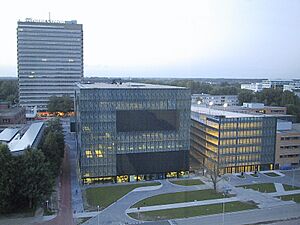
Utrecht has several large colleges and universities. The most important is Utrecht University. It was founded in 1636. It is the largest university in the Netherlands with over 30,000 students. The university has buildings in the city center and at the Uithof campus. In 2014, it was ranked among the top universities in the world. Utrecht also has the smaller University of Humanistic Studies.
Utrecht is home to a branch of TIAS School for Business and Society. This school focuses on business education for experienced professionals. It is the largest management school of its kind in the Netherlands.
Two other large schools in Utrecht are the Hogeschool Utrecht (a vocational university with 37,000 students) and the HKU Utrecht School of the Arts (3,000 students).
There are many schools for primary and secondary education. Parents can choose schools based on different teaching styles or religions. This is part of the Dutch school system.
Culture and Arts
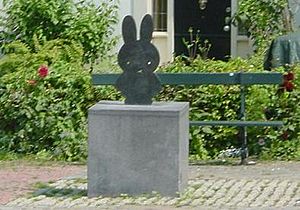
Utrecht has a lively cultural scene. It is second only to Amsterdam in the Netherlands. There are several theaters and theater groups. The main city theater was built in 1941. Besides theaters, there are many cinemas, including three art-house cinemas. Utrecht hosts the international Early Music Festival and the Netherlands Film Festival. The city has an important classical music hall called Vredenburg. Its sound quality is considered excellent. The original Vredenburg music hall was redeveloped. In 2014, it became TivoliVredenburg, combining different music venues. Young musicians study at the conservatory, which is part of the Utrecht School of the Arts. There is also a special museum for automatically playing musical instruments.
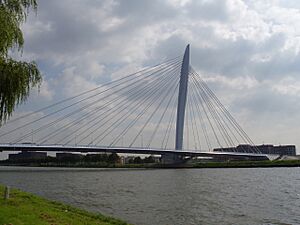
Utrecht has many art galleries. There are also groups that support art and artists. Artists are trained at the Utrecht School of the Arts. The Centraal Museum has many art exhibitions. It also has a permanent display of works by Utrecht artist Dick Bruna, who created Miffy. BAK (Basis for Contemporary Art) shows modern art and hosts public events. The Rietveld Schröder House from 1924 is a famous example of modern architecture. It is a World Heritage Site recognized by UNESCO.
Every Saturday, a stone is added to The Letters of Utrecht. This is an endless poem in the cobblestones of the Oude Gracht. It is a growing monument for future generations.
Utrecht organizes "cultural Sundays" to promote culture. On these days, different organizations offer programs that are free or have reduced entry fees. There are also groups for amateur artists. The city helps fund an organization for amateur arts education.
In 2017, Utrecht was named a UNESCO City of Literature. In 2025, the national literature museum will move from The Hague to Utrecht.
Sports in Utrecht
Utrecht is home to the professional football club FC Utrecht. They play at Stadium Nieuw Galgenwaard. It is also home to Kampong, the largest amateur sports club in the Netherlands. Kampong has teams for field hockey, football, cricket, tennis, squash, and boules. Utrecht also has a baseball and softball club, UVV. The rugby club USRS has played in the highest Dutch leagues since 1967. Several rowing clubs use Utrecht's waterways.
In July 2013, Utrecht hosted the European Youth Olympic Festival. Over 2,000 young athletes competed in nine Olympic sports. In July 2015, Utrecht hosted the start of the Tour de France cycling race.
Museums to Explore
Utrecht has several museums, many located in the Museumkwartier (Museum Quarter) in the old town.
- Centraal Museum: This city museum has a large collection of art, design, and historical items. It includes a special section for Miffy creator Dick Bruna.
- Museum Catharijneconvent: This museum shows the history of Christian culture and art in the Netherlands.
- Museum Speelklok: This national museum displays many mechanical musical instruments from different centuries.
- Railway Museum (Nederlands Spoorwegmuseum): This museum tells the history of Dutch railways.
- Universiteitsmuseum (Utrecht): The Utrecht University museum includes an old botanical garden.
- Sonnenborgh Observatory: This observatory and museum often hosts talks about astronomy.
Music and Events
The city has several music venues like TivoliVredenburg, Tivoli De Helling, and EKKO. Utrecht hosts the yearly Utrecht Early Music Festival. The city also hosts the Le Guess Who? festival in November, which focuses on indie rock and experimental rock.
Theatre Performances
Utrecht has two main theaters: the Theater Kikker and the Stadsschouwburg Utrecht. The Parade, a traveling theater festival, performs in Utrecht in the summer. The city also hosts the yearly Festival aan de Werf. This festival offers modern international theater, visual arts, and music.
Famous People from Utrecht
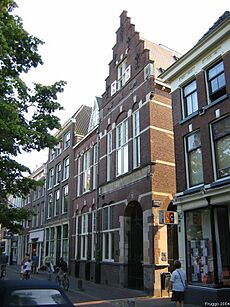
Many famous people were born or grew up in Utrecht.
- Pope Adrian VI (1459–1523): A leader of the Catholic Church.
- Marco van Basten (born 1964): A famous football player.
- Dick Bruna (1927–2017): A writer and illustrator, best known for creating Miffy.
- Anton Geesink (1934–2010): A judoka, the first non-Japanese world champion in Judo.
- Gerrit Rietveld (1888–1964): A designer and architect, part of the De Stijl art movement.
- Dafne Schippers (born 1992): An Olympic sprinter.
- Herman van Veen (born 1945): An actor, musician, and author of Alfred J. Kwak.
International Connections
Utrecht has connections with other cities around the world.
Twin Cities
Utrecht is twinned with:
Friendship City
 Portland, Oregon, United States
Portland, Oregon, United States
See also
 In Spanish: Utrecht para niños
In Spanish: Utrecht para niños


